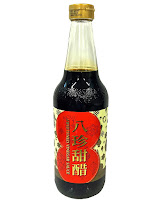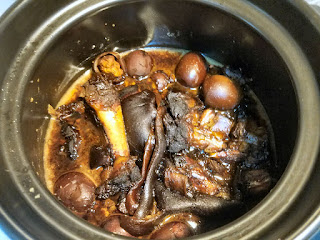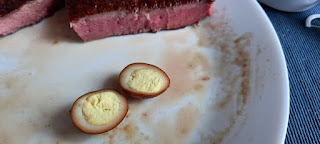This is a iron and calcium rich Cantonese Style Post-partum / dim sum recipe, made with pigs feet / trotters and ginger in aged sweet black rice vinegar. Made with 4 ingredients, it's a very simple dish that just takes time and patience to get right.
It's traditionally eaten by pregnant women (and their families, and guests) starting from the 12th day after giving birth, for about four weeks, but is also a very popular dimsum dish that's very popular with the ladies, especially during the winter months.
One massive pot of ginger and sweet vinegar is traditionally prepared a few weeks before the child is expected, allowed to steep for a while, and then pigs feet and eggs are cooked in the spicy vinegar and left to rest for a day before serving. Optionally, additional young ginger can be added.
This meaty Ming dynasty dish tastes both sweet and sour, tempering a mild undertone of spicyness. It stimulates the appetite, and has healing properties.
Scientific research has shown this dish to be fairly high in calcium and iron, which are important for women during post-partum recovery. For reference, post-partum women are encouraged to consume 1000-1200mg of calcium and 18mg of iron per day.
Median (interquartile range) calcium and iron contents of the ginger vinegar soup were 4.65 (2.87±6.30) and 0.84 (0.57± 1.05) mg/dl, respectively. This calcium content was higher than that of the other six soup samples, but was low as compared with other calcium-rich foods.
Iron content of ginger vinegar soup was higher than that of the other six samples and was comparable to some iron-rich foods.
A dl (decaliter) is 100ml, or ~3.3oz. The research paper didn't do analysis on the calcium & iron content of the pig trotters and eggs, just the ginger vinegar soup. The iron and calcium from the pig feet dissolve in the acidic vinegar soup, and the collagen is melted during the long simmer. Black rice vinegar has been also taken in the east for many supposed health benefits (much like ACV in the west).
Eggs are great for pregnant and post-partum women, as their yolks contain vitamins A, D, E and K, folate, B12, choline and omega-3 fats. Get pastured eggs, or omega3 enriched eggs if you can, but any eggs in general should be a part of a post partum diet. Research has found an association between low omega-3 levels and postpartum depression and that supplementation may help reduce your risk. Eggs are also a great source of choline, which is very important for brain development, and necessary if you are breast feeding.
Additional notes:
Ginger: This dish has a lot of ginger and it’s recommended that pregnant women who are close to labor or who’ve had miscarriages avoid ginger. Ginger is contraindicated with a history of vaginal bleeding and clotting disorders.
If young ginger is used, and eaten, the extra fiber is good for digestion, there's also some soluble fiber from the ginger, as well as vitamin C.
From a TCM perspective, the large amounts of ginger is warming, good for dispelling wind-cold, beneficial to the digestive system, and aids the circulatory system (blood thinning). Scientifically, cooked ginger has a compound called Zingerone (created when another compound Gingerol is heated) which has many health benefits.
Zingerone has potent anti-inflammatory, antidiabetic, antilipolytic, antidiarrhoeic, antispasmodic, and so forth properties. Besides, it displays the property of enhancing growth and immune stimulation. It behaves as appetite stimulant, anxiolytic, antithrombotic, radiation protective, and antimicrobial.
Black rice vinegar is believed to be good for the arteries, it's also acidic which helps preserve food, and also dissolve calcium and iron from the pig trotters. The sweetened black vinegar is also rather high in sugar, which may provide a quick energy boost to sleep deprived post-partum family members. It's also supposed to help with post-partum depression.
My preferred brand is one from Hong Kong, called Pat Chun, started by a Shunde chef in 1932. Shunde is a district in Foshan, Guangdong province that's famed for it's culinary skills. They are fairly small, and have a few shops in Hong Kong with one in Singapore.
Alternatively, it can be substituted with equal parts Chinkiang Vinegar and Molasses, diluted with water, and additionally sweetened with dark brown cane sugar to taste (Amazon links to the good stuff). Dark Brown Cane sugar is also used in TCM to relieve period cramps.
Pig trotters are high in collagen, a major building blocks of bones, skin, muscles, tendons, and ligaments. Collagen is also found in many other body parts, including blood vessels, corneas, and teeth.
I've also cooked this dish using pork knuckles, taking care to cook it in my ceramic pot in a low simmer to avoid overcooking meat fibers, and serving immediately after cooking.
History & Culture
Supposedly, in the Ming Dynasty (1368 to 1644CE) , there was a butcher who's mother kicked out his wife for being unable to bear children. Being unhappy with the decision, the butcher "spent a lot of time with his wife", whom the legend says is very good looking. Lo and behold, she ends up getting pregnant, and bearing him a son.
Worried that she was malnourished, he cooked up leftover meat from his work and served it to her after she gave birth, cooked in broth of ginger and sweet vinegar (loyal readers will know that I've also just had a kid, and pregnant wives need a LOT of TLC, as well as protein and calcium, so I hope he was also keeping her well fed during her pregnancy)
After some time, the wife forgave her mother in law, and sent her son with a pot of sweet vinegar stew as a token.
In Cantonese culture, the future grandmothers will usually prepare this for the pregnant wife, and "encourage" her to drink the soup, and eat the trotters & eggs starting from the 12-14th day after giving birth, for about 4-6 weeks.
Pig trotters and eggs, along with the ginger vinegar soup are traditionally served to family and friends who visit the family this time. I have female friends who can't even stand the smell of this dish, saying they were forced to drink too much of this at one time.
Cooking Notes
Vinegar is acidic, so ONLY use non-reactive cookware to cook and store this. Glass, ceramic and stainless steel are non-reactive. Cast Iron, Carbon steel, aluminum, copper etc are reactive. You can use a enameled dutch oven like a le crueset, but cheaper ceramic/clay pots are frequently used.
The traditional recipe calls for the ginger and vinegar to age in a clay pot for two weeks before using it to cook the pork. While I understand that the vinegar is very sweet and acidic and doesn't go bad, I'm more comfortable with storing this in a glass jar in the fridge.
Anecdotal advice from Chinese chefs say that this gingered vinegar can be used "perpetually", as long as it's topped up with 老陈醋 mature rice vinegar periodically, and boiled every time you add ginger. At time of writing this blog, my jar of sweet vinegar "soup" is 6 months old, and I've cooked about 6 batches pork trotters / knuckles / eggs with it. Quail eggs are absolutely amazing with it.
Front pig's trotter has a higher ratio of meat to collagen, whereas hind trotters tend to have more tendons. For more meat, use front trotters, for more collagen, use hind trotters. Or use it to cook pork knuckles.
Old ginger is more aromatic and spicy whereas the young ginger has a certain fragrance to it. However, if you like to eat the ginger as well, add a few pieces of young ginger when cooking the pork. The easiest way to peel old ginger, is with a metal spoon. The ginger skin can be dried and used as a hot foot soak as a folk remedy for arthritis
Change the amount of sweet vinegar (yellow box) accordingly
As always, recipe amounts are just suggestions.
Recipe ratio taken from research done on 51 families in Hong Kong
Recipe Structure
1) Wash, peel and dry the ginger, and pan fry it lightly before boiling it with the vinegar.
i) Cut the ginger into large chunks, then slice them down the middle to halve their thicknessii) Give them a few hits with the flat of your knives to flatten and crack them.iii) Dry them by stir frying them in the wok over high heat for a few minutes
iv) This is a traditional step to help the ginger's "wind reducing properties". It also gives the ginger a little char, which adds a little smoky flavor to the vinegar.
2) Boil the ginger with the vinegar for an hour or two
i) This helps to create some of that Zingerone compoundii) Top up the pot with additional sweet black vinegar. This concentrates the ginger-vinegar soup. Use water if you prefer it less potentiii) Use a non-reactive pot. Traditionally, a clay pot is used, which needs to be warmed slowly to prevent cracking. Alternatives are glass pots or stainless steel pots.
3) Let the ginger seep into the vinegar soup in the fridge overnight or more.
i) Traditionally, this ginger+vinegar is left at room temperature (in the temperate / sub-tropical Southern China / Hong Kong region) for at least 3-4 weeks, being brought to a boil once a week.
4) Par-boil / Cleanse the pig feet
i) Cut the pig feet in to large chunks, about 6cm / 2 inches squareii) Starting with the meat in a pot of cold water, bring the water to a boil. Ginger and Shaoxing wine can also be used to help remove any gamey flavors.iii) Rinse the par-boiled pig feet in clean cold water, plucking hairs if any.
5) Simmer the pig feet in the gingery vinegar soup for 90min
i) Cooking time can be lowered to 45min if you like the meat chewier / intend to steep the pig feet for a few days (up to 2 weeks).ii) Traditionally, the pig feet are left to steep in the ginger vinegar soup for 1-2 weeks before serving. This allows the vinegar to dissolve more calcium and iron from the pig feet. We can reduce this time by boiling the meat for longer. This pork+ginger+vinegar soup is also left at room temperature, and boiled every three days.iii) Cook the pig feet for longer (up to 2 hours) if you intend to serve immediately, but I suggest letting it steep at least overnight in the fridge. If using meatier cuts like pork knuckle, avoid steeping it overnight and serve immediately. The vinegar "cooks" the meat proteins making them tough.
6) Add peeled, hard boiled eggs to the gingery vinegar soup.
Become a Patron!i) Let the eggs boil for an hour if you intend to serve immediatelyii) The eggs can be left to steep in the ginger vinegar solution for 1-2 days before serving.iii) The eggs can also be boiled along with the pork+ginger+vinegar soup once every three days, which will cause the egg whites to further harden.. This is similar to a Taiwanese dish called "iron eggs" which are almost like a small, rubbery, shrunken egg.iv) You can also use quail eggs. Those are delicious.v) I intend to try soft boiled eggs, and see what kinda ramen eggs they make.
7) Reserve any unused ginger+vinegar for next time.
i) I remove the solidified layer of fat from the vinegar before re-using itii) You can also cook lotus roots, or soak quail eggs in the ginger+vinegar soup.
 |
| These are freaking delicious |





i have tried the eggs ni-tamago style and they are excellent
ReplyDelete